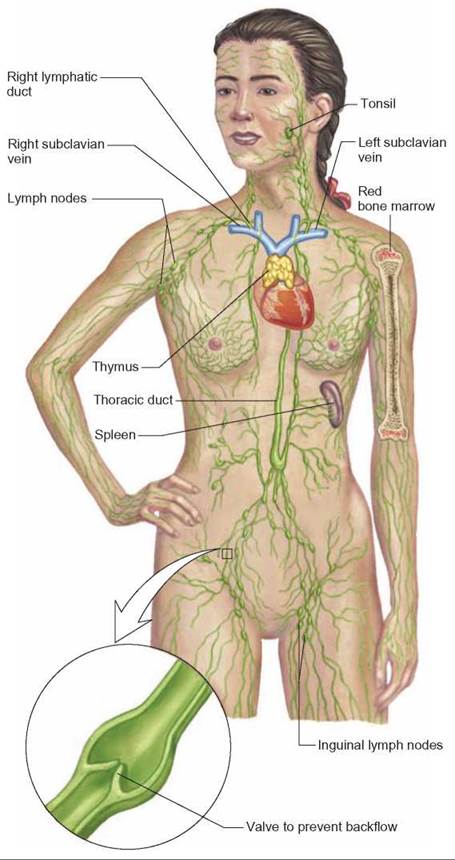CONCEPTS IN BIOLOGY
PART VI. PHYSIOLOGICAL PROCESSES
24. Materials Exchange in the Body
24.3. The Lymphatic System
The lymphatic system is a collection of lymph organs and thin-walled tubes (lymph vessels) that branch throughout the body. The lymphatic system plays three important roles: (1) It moves fat from the intestinal tract to the bloodstream, (2) it transports excess tissue fluid back to the cardiovascular system, and (3) it defends against harmful agents, such as bacteria and viruses (refer to chapter 26, Immunity). Lymph is tissue fluid that moves through this system.
Lymph vessels collect lymph and ultimately empty it into two large veins near the heart. Because the lymph vessels have valves to prevent backflow, lymph is moved one way through the vessels as a result of the contraction of the body’s muscles. For this system to function properly, the person must be active, or the tissue fluid will not move into the lymph vessels and will build up, causing the tissue to swell, a condition called edema. Edema is common in circulatory disorders. Another cause of edema results from an increase in capillary permeability as a result of injury. Fluid moves from inside the blood vessels into the damaged tissue and is seen as swelling. A swollen sprained ankle or smashed thumb are examples you may have experienced. Figure 24.5 shows the structure of the lymphatic system.

FIGURE 24.5. The Lymphatic System
Lymphatic vessels drain the tissue fluid that surrounds cells and return it to the cardiovascular system near the heart. The enlargement shows that lymphatic vessels have valves to prevent backflow. The lymph nodes, tonsils, spleen, thymus gland, and red bone marrow are lymph organs.
There are five types of lymph organs: (1) lymph nodes, (2) tonsils, (3) spleen, (4) thymus, and (5) red bone marrow. Lymph nodes are small encapsulated bodies found along the lymph vessels that contain large numbers of white blood cells (wbc), particularly macrophages and lymphocytes that remove microorganisms and foreign particles from the lymph. As the lymph makes its way back to the circulatory system, it is filtered by lymph nodes. When nodes are actively engaged in this cleanup, they swell as the wbc population increases. During an examination, physicians palpate or feel the nodes (usually in the neck) to help determine if a person has an infection.
The tonsils are lymph organs located on either side of the throat. Adenoids are lymph organs located at the back of the nasal cavity. Their job, like that of lymph nodes, is to clean the lymph of pathogens. Because they are so close to the mouth and nose, they are likely to encounter pathogens and become swollen as the number of white blood cells increases. In the past, if tonsils repeatedly became “infected” and unable to manage pathogens, they were removed by a surgical procedure called a tonsillectomy. This procedure was performed on children who displayed chronic sore throats or infections. Today, the functions of tonsils are better understood and tonsillectomies are rarely performed.
The spleen also contains large numbers of white blood cells and filters the blood. It is about the size of a small pickle, located in the upper left side of the body just below the diaphragm. Its job is to clean the blood of pathogens and worn- out or damaged rbcs. Should the spleen be ruptured as a result of an accident or a wound, it may have to be removed. In such cases, the person loses an important blood-filtering and disease-fighting organ.
The thymus gland, located beneath the breastbone, is large and active in children. As a person ages, the thymus shrinks and may actually disappear. Its primary function is to produce wbcs, which are vital to the functioning of the immune system. These cells, called T-lymphocytes, are distributed from the thymus throughout the body and establish themselves in lymph nodes. Even though the thymus shrinks in size into adulthood, the descendants of the T-lymphocytes it produced earlier in life are still active throughout the lymphatic system.
The red bone marrow produces red and white blood cells and platelets. Stem cells found inside these bones continue to divide throughout a person’s life, providing a continuous supply of rbcs and wbcs. Red bone marrow is found in most of a child’s bones. In adults, the red bone marrow is only found in the pelvis (hipbone), sternum (breastbone), skull, clavicle (collarbone), ends of long bones, and vertebrae (backbone).
24.3. CONCEPT REVIEW
5. What purposes are served by the lymphatic system?
6. List the organs of the lymphatic system and describe the function of each.